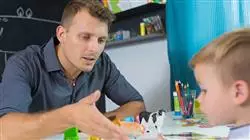University certificate
The world's largest faculty of psychology”
Introduction to the Program
Acquire the knowledge of a specialist in Therapeutic Pedagogy and get the real competences necessary to be able to work in this area full of development opportunities”

Psychologists, due to their training, are one of the professionals with the best capacity for development in the intervention from Therapeutic Pedagogy. This work is such a niche that schools and diverse organizations have become an opportunity to guide the training of these professionals. Acquiring the necessary updating in the different advances and techniques of intervention and specific training is complex, due to its breadth and dispersion.
This comprehensive program was developed in response to the growing demand for training in the area of special needs in schools. The international regulations of the organizations in charge of overseeing the integral development of people with disabilities, and specifically, of children with difficulties in schools, have promoted a new model of teaching work. This approach represents a giant step forward in the obsolete segregationist system that has dominated until now and is directed towards a capacity for attention that generates a more realistic and effective integration.
To achieve these objectives, this Master's Degree will take students through the knowledge that intervention in therapeutic pedagogy requires. From the consideration of communication with the family or legal guardians as a pillar around which any intervention should pivot to the planning and development of intervention processes.
All these processes must be materialized in a real and possible adaptation to the needs of each student, in a totally individualized manner. To this end, TECH will show in an intensive and complete study, how to elaborate the educational adaptations using the most innovative tools and material resources, to create a process that allows students to really learn, taking into account their optimal ways of facing each area of study.
All this work capacity that the student will acquire will inevitably be supported by the knowledge of the bases of psychology in this area and the approaches of the sciences of education and neurology. In addition, you will learn how to interpret and use industry reports and publications as tools for professional growth.
In summary, this training aims to prepare teaching professionals for the practice of Therapeutic Pedagogy in the necessary push for an inclusive, adapted and empowering education.
As a Psychologist, you will learn the most innovative approaches of Therapeutic Pedagogy and begin to intervene in this exciting field”
This Master's Degree in Therapeutic Pedagogy for Psychologists contains the most complete and up-to-date scientific program on the market. The most important features of the Master's Degree include:
- The development of practical cases presented by experts in Therapeutic Pedagogy
- The graphic, schematic, and eminently practical contents with which they are created provide scientific and practical information on the disciplines that are essential for professional practice
- New developments in Therapeutic Pedagogy
- Practical exercises where self-assessment can be used to improve learning
- An emphasis on innovative methodologies in the field of Therapeutic Pedagogy
- Theoretical lessons, questions to the expert, debate forums on controversial topics, and individual reflection assignments
- Content that is accessible from any fixed or portable device with an Internet connection
Get access to the world of Therapeutic Pedagogy and its developments, in a complete Master's Degree created to propel you to another professional level”
Its teaching staff includes leading professionals and experts who bring their years of experience to this program, as well as renowned specialists belonging to prestigious societies and universities.
The multimedia content, developed with the latest educational technology, will provide the professional with situated and contextual learning, i.e., a simulated environment that will provide an immersive training program designed to train in real situations.
The program design is based on Problem-Based Learning, by means of which the educator must try to solve the different professional practice situations that arise throughout the academic course. To do so, the educator will have the help of an innovative interactive video system that provides the contextualization and the practical point of view you need.
Acquire the real working skills of a specialist in Therapeutic Pedagogy and you can offer any institution quality work and the development in this area of fundamental interest"

Learn in a simple, intensive and flexible way with the quality of the highest rated teaching models in the online teaching scene"
Why study at TECH?
TECH is the world’s largest online university. With an impressive catalog of more than 14,000 university programs available in 11 languages, it is positioned as a leader in employability, with a 99% job placement rate. In addition, it relies on an enormous faculty of more than 6,000 professors of the highest international renown.

Study at the world's largest online university and guarantee your professional success. The future starts at TECH”
The world’s best online university according to FORBES
The prestigious Forbes magazine, specialized in business and finance, has highlighted TECH as “the world's best online university” This is what they have recently stated in an article in their digital edition in which they echo the success story of this institution, “thanks to the academic offer it provides, the selection of its teaching staff, and an innovative learning method aimed at educating the professionals of the future”
A revolutionary study method, a cutting-edge faculty and a practical focus: the key to TECH's success.
The most complete study plans on the university scene
TECH offers the most complete study plans on the university scene, with syllabuses that cover fundamental concepts and, at the same time, the main scientific advances in their specific scientific areas. In addition, these programs are continuously being updated to guarantee students the academic vanguard and the most in-demand professional skills. In this way, the university's qualifications provide its graduates with a significant advantage to propel their careers to success.
TECH offers the most comprehensive and intensive study plans on the current university scene.
A world-class teaching staff
TECH's teaching staff is made up of more than 6,000 professors with the highest international recognition. Professors, researchers and top executives of multinational companies, including Isaiah Covington, performance coach of the Boston Celtics; Magda Romanska, principal investigator at Harvard MetaLAB; Ignacio Wistumba, chairman of the department of translational molecular pathology at MD Anderson Cancer Center; and D.W. Pine, creative director of TIME magazine, among others.
Internationally renowned experts, specialized in different branches of Health, Technology, Communication and Business, form part of the TECH faculty.
A unique learning method
TECH is the first university to use Relearning in all its programs. It is the best online learning methodology, accredited with international teaching quality certifications, provided by prestigious educational agencies. In addition, this disruptive educational model is complemented with the “Case Method”, thereby setting up a unique online teaching strategy. Innovative teaching resources are also implemented, including detailed videos, infographics and interactive summaries.
TECH combines Relearning and the Case Method in all its university programs to guarantee excellent theoretical and practical learning, studying whenever and wherever you want.
The world's largest online university
TECH is the world’s largest online university. We are the largest educational institution, with the best and widest online educational catalog, one hundred percent online and covering the vast majority of areas of knowledge. We offer a large selection of our own degrees and accredited online undergraduate and postgraduate degrees. In total, more than 14,000 university degrees, in eleven different languages, make us the largest educational largest in the world.
TECH has the world's most extensive catalog of academic and official programs, available in more than 11 languages.
Google Premier Partner
The American technology giant has awarded TECH the Google Google Premier Partner badge. This award, which is only available to 3% of the world's companies, highlights the efficient, flexible and tailored experience that this university provides to students. The recognition as a Google Premier Partner not only accredits the maximum rigor, performance and investment in TECH's digital infrastructures, but also places this university as one of the world's leading technology companies.
Google has positioned TECH in the top 3% of the world's most important technology companies by awarding it its Google Premier Partner badge.
The official online university of the NBA
TECH is the official online university of the NBA. Thanks to our agreement with the biggest league in basketball, we offer our students exclusive university programs, as well as a wide variety of educational resources focused on the business of the league and other areas of the sports industry. Each program is made up of a uniquely designed syllabus and features exceptional guest hosts: professionals with a distinguished sports background who will offer their expertise on the most relevant topics.
TECH has been selected by the NBA, the world's top basketball league, as its official online university.
The top-rated university by its students
Students have positioned TECH as the world's top-rated university on the main review websites, with a highest rating of 4.9 out of 5, obtained from more than 1,000 reviews. These results consolidate TECH as the benchmark university institution at an international level, reflecting the excellence and positive impact of its educational model.” reflecting the excellence and positive impact of its educational model.”
TECH is the world’s top-rated university by its students.
Leaders in employability
TECH has managed to become the leading university in employability. 99% of its students obtain jobs in the academic field they have studied, within one year of completing any of the university's programs. A similar number achieve immediate career enhancement. All this thanks to a study methodology that bases its effectiveness on the acquisition of practical skills, which are absolutely necessary for professional development.
99% of TECH graduates find a job within a year of completing their studies.
Master's Degree in Therapeutic Pedagogy for Psychologists
The educator Paulo Freire once said, "Teaching is not transferring knowledge, but creating the possibilities for its own production or construction." In the educational paradigm, this should be a recurring principle, as the educational system is not a mere passive medium for cognitive extraction; it must be an active environment that adapts to the formative autonomy of the individual, particularly when addressing specific cases such as Attention Deficit Disorder (ADD). Psychology plays a vital role as an excellent mediator in this context. At TECH Global University, we aim to enhance your studies and foster growth in the educational environment with the Master’s Degree in Therapeutic Pedagogy for Psychologists: a comprehensive exploration of the history of teaching from a multidisciplinary perspective, as well as a deep dive into the various neurodevelopmental disorders, including mental illnesses such as schizophrenia and anxiety. With a methodology that is gaining worldwide recognition for its remarkable results and a convenient 100% online format, TECH offers you the best professional development opportunity.
Psychology and therapeutic pedagogy: your path to success
Between 2% and 5% of the global child population suffers from Attention Deficit Hyperactivity Disorder (ADHD). Of that range, more than 80% continue to show the same symptoms during adolescence, and between 30% and 65% still experience them into adulthood. The greatest challenge of this psychiatric condition is, of course, providing an educational framework that complements clinical treatment. This is why a postgraduate program like this is essential. In ten modules, covered over 1500 hours, we offer the opportunity to address not only this disorder but also several others, including musculoskeletal and nervous system-related conditions, for which psychomotor therapies are ideal. Our faculty is among the most highly qualified available, and the flexible class model, combined with learning methodologies like the Relearning system, will allow you to gain greater knowledge in record time. Do you want to become an outstanding educator and/or counselor? Start by enrolling with us.







